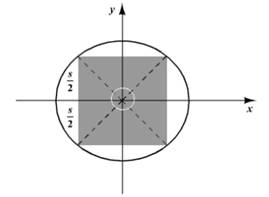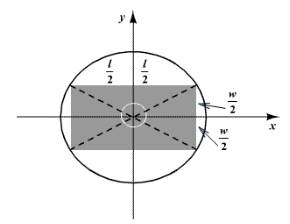
Concept explainers
To explain: the position of the arm, the length andwhen to use more than one arm
Answer to Problem 63AYU
Square field:
It is concluded that the arm should be positioned at a distance of
Rectangular field:
It is concluded that the arm should be positioned at a distance of
A circle is not circumscribed around a long rectangle with the diagonal as its diameter. Thus, it becomes desirable to use more than one arm.
Explanation of Solution
Given:

First, consider the square field. Let s be the side length of the square field.

From the figure, the arm is positioned at the center of the circle and its length should be the radius.
By the Pythagorean theorem, the diagonal of the square field is
That is, the center of the circle is
Thus, it is concluded that the arm should be positioned at a distance of
Now, consider the rectangular field. Let

In this case also, the arm is positioned at the center of the circle and its length should be the radius.
By the Pythagorean theorem, the diagonal of the rectangular field is
That is, the center of the circle is
Thus, it is concluded that the arm should be positioned at a distance of
When the length of a rectangular field is much larger than its width, the watering pattern cannot be a circle. This is because a circle is not circumscribed around a long rectangle with the diagonal as its diameter.
Thus, it becomes desirable to use more than one arm.
Conclusion:
Square field:
It is concluded that the arm should be positioned at a distance of
Rectangular field:
It is concluded that the arm should be positioned at a distance of
A circle is not circumscribed around a long rectangle with the diagonal as its diameter.Thus, it becomes desirable to use more than one arm.
Chapter 1 Solutions
Precalculus
Additional Math Textbook Solutions
University Calculus: Early Transcendentals (4th Edition)
College Algebra with Modeling & Visualization (5th Edition)
Elementary Statistics: Picturing the World (7th Edition)
Elementary Statistics
Calculus: Early Transcendentals (2nd Edition)
- Calculus III May I have an expert explain how the integrand was simplified into the final for form to be integrated with respect to x? Thank you,arrow_forwardCalculus lll May I please have the semicolon statement in the box defined with explanation? Thank you,arrow_forwardCalculus lll May I please have the solutions for the following blank lines? Thank you,arrow_forward
- 8:38 *** TEMU TEMU -3 -2 7 B 2 1 & 5G. 61% 1 2 -1 Based on the graph above, determine the amplitude, period, midline, and equation of the function. Use f(x) as the output. Amplitude: 2 Period: 2 Midline: 2 ☑ syntax error: this is not an equation. Function: f(x) = −2 cos(πx + 2.5π) +2× Question Help: Worked Example 1 ☑ Message instructor Submit Question ||| <arrow_forward8:39 *** TEMU 5G 60% A ferris wheel is 28 meters in diameter and boarded from a platform that is 2 meters above the ground. The six o'clock position on the ferris wheel is level with the loading platform. The wheel completes 1 full revolution in 4 minutes. The function h = f(t) gives your height in meters above the ground t minutes after the wheel begins to turn. What is the amplitude? 14 meters What is the equation of the Midline? y = 16 What is the period? 4 meters minutes The equation that models the height of the ferris wheel after t minutes is: f(t): = ƒ (3) = ·−14(0) + 16 syntax error: you gave an equation, not an expression. syntax error. Check your variables - you might be using an incorrect one. How high are you off of the ground after 3 minutes? Round your answe the nearest meter. ||| <arrow_forwardcan you solve this question step by step pleasearrow_forward
 Calculus: Early TranscendentalsCalculusISBN:9781285741550Author:James StewartPublisher:Cengage Learning
Calculus: Early TranscendentalsCalculusISBN:9781285741550Author:James StewartPublisher:Cengage Learning Thomas' Calculus (14th Edition)CalculusISBN:9780134438986Author:Joel R. Hass, Christopher E. Heil, Maurice D. WeirPublisher:PEARSON
Thomas' Calculus (14th Edition)CalculusISBN:9780134438986Author:Joel R. Hass, Christopher E. Heil, Maurice D. WeirPublisher:PEARSON Calculus: Early Transcendentals (3rd Edition)CalculusISBN:9780134763644Author:William L. Briggs, Lyle Cochran, Bernard Gillett, Eric SchulzPublisher:PEARSON
Calculus: Early Transcendentals (3rd Edition)CalculusISBN:9780134763644Author:William L. Briggs, Lyle Cochran, Bernard Gillett, Eric SchulzPublisher:PEARSON Calculus: Early TranscendentalsCalculusISBN:9781319050740Author:Jon Rogawski, Colin Adams, Robert FranzosaPublisher:W. H. Freeman
Calculus: Early TranscendentalsCalculusISBN:9781319050740Author:Jon Rogawski, Colin Adams, Robert FranzosaPublisher:W. H. Freeman
 Calculus: Early Transcendental FunctionsCalculusISBN:9781337552516Author:Ron Larson, Bruce H. EdwardsPublisher:Cengage Learning
Calculus: Early Transcendental FunctionsCalculusISBN:9781337552516Author:Ron Larson, Bruce H. EdwardsPublisher:Cengage Learning





